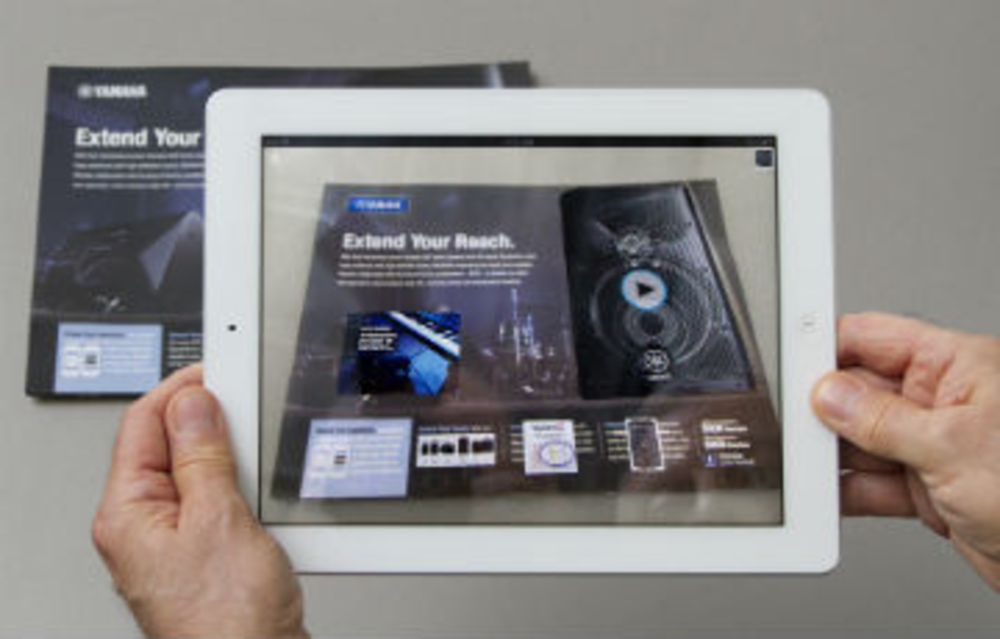There are only 37 days until Black Friday. That means marketers have a little more than a month to complete their orchestration of the perfect holiday campaign. Musical instrument and audio product manufacturer Yamaha Corporation of America decided to symphonize digital and print this holiday season by introducing new interactive and augmented reality magazine print ads.
To promote its new DXR Series Speakers and DXS Series Subwoofers—speakers for the live sound market, such as an outdoor concert venue—Yamaha’s live sound department and customer experience group added digital components to its traditional print ads. After a customer scans an ad with Yamaha Hub, the brand’s iOS app, parts of the ad become three dimensional and pop-up icons appear. These allow users to access exclusive digital content about the product, including photos, videos, social interactions.
“Marrying print with digital is where we see the future going rather than completely taking the print dollars and shifting them into pure digital,” says Jeff Hawley, director of the customer experience group for Yamaha.
The augmented reality reader, powered by Layar, is the latest addition to the Yamaha Hub. The app, which originally debuted three years ago, also features a QR reader, as well as an INFOSOUND reader—a proprietary tool that decodes information via inaudible sound signals. Adding this augmented reality component gives Yamaha the ability to track and analyze engagement for each interactive element. Instead of simply tracking that eight people scanned an ad, for instance, Yamaha can now detect how many of those people then watched a video or engaged with the brand via social, Hawley says. As a result, Yamaha can extend an ad’s longevity by updating the augmented reality ad experience based on the engagement data—including adding more videos or changing product images—even after the printed ad has hit the presses. For example, a URL associated with the ad may initially lead to a product page, then be changed to lead to a new model, and then to a limited time sweepstakes. Yamaha can then track those URLs month to month. Hawley says these new ads will help Yamaha identify which forms of interactive content consumers engage with the most, as well as showcase key Yamaha product features.
“Once it’s printed, it’s out and it’s impossible to change,” Hawley says about traditional print ads. “But there are some neat opportunities to extend the life [of a print ad] and adjust on the fly how an ad performs and what sort of things we’re offering in the ad once it’s out.”
Many of the new advertisements will appear in the November issues of Drum! and Guitar World magazines, as well as the 30th issue of M Music and Musicians; however, Hawley says a few were released early as tests. In fact, he says Yamaha is seeing a five to 10 times increase in the number of scans and engagement compared to QR codes.
In addition, Hawley notes that print provides many benefits that can’t be replicated in other channels, including immediate content with a flip of a page and uninterrupted context. In some cases prospective customers might go to the Web with the intention of shopping for speakers; however, banner ads for shoes or pet food can easily throw them off course. But if someone open an ad in a music magazine they’re already in that mind-set, he explains. Even augmented reality, Hawley argues, has certain benefits that QR codes can’t provide. For example, a consumer who scans a QR code may still see the same content as a consumer who didn’t scan the QR code. Hence, the person potentially scanning the QR code may not see the value of taking that extra step.
“I think there’s been a tendency to use QR for QR’s sake,” he says. “Going into augmented reality, we wanted to make sure that this is exclusive, only in the ad content…. We really do think that that the marriage between print and the digital overlay is unique and may tell the story of the product in a more effective manner than just pointing [customers] to a web page.”








